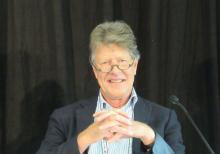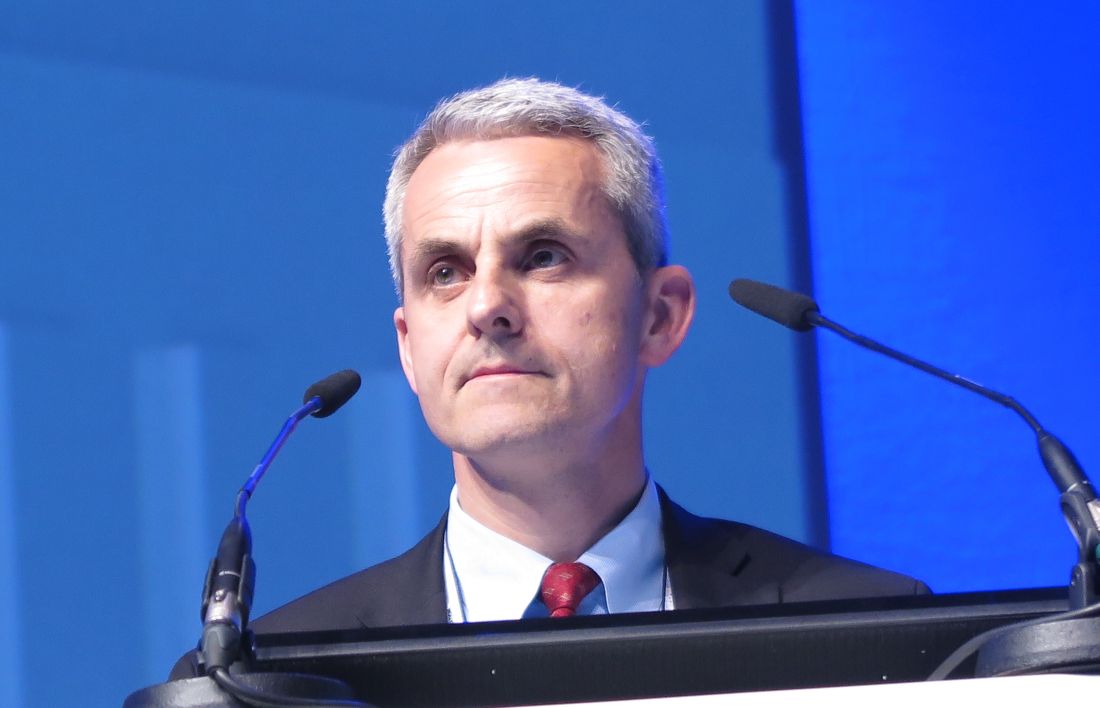User login
MADRID – With some genetic sleight-of-hand, investigators hope to mimic a rare, naturally occurring mutation that protects some patients with beta-thalassemia or sickle-cell disease (SCD) from becoming symptomatic.
Although human studies have yet to begin, investigators in a biotech company report that they can use CRISPR/Cas9 gene editing to recreate the rare condition known as hereditary persistence of fetal hemoglobin, or HPFH, which causes some patients with SCD or beta-thalassemia to continue to produce the fully functional fetal rather than adult form of hemoglobin into adulthood.
To date, there have been no detectable undesirable off-target genetic modifications seen by targeted deep sequencing for the two leading guide RNAs (gRNA) in development, he said at the annual congress of the European Hematology Association.
“Patients with sickle-cell disease and beta-thalassemia are not sick when they are first born, but symptoms develop shortly after birth as the fetal hemoglobin levels decline, and as adult hemoglobin rises,” Dr. Lundberg said.
Fetal hemoglobin has been shown to reduce the risk of sickle events in SCD, and reduce symptoms and morbidity of beta-thalassemia.
“Modest amounts of fetal hemoglobin are beneficial, and more appears to be better,” he said.
In rare instances, the genetic switch to turn off fetal hemoglobin fails, leading to HPFH. It is this rare circumstance that the investigators hope to copy.
CRISPR/Cas9 technology copies a bacterial defense mechanism using clustered regularly interspaced short palindromic (CRISPR) repeats of DNA as a template for adaptive immunity against viruses and plasmids. The system allows bacteria to prevent the activation of invading nucleic acids by effectively snipping out target sequences of foreign DNA.
The investigators plan to harvest hematopoietic stem cells from patients with SCD and beta-thalassemia and use CRISPR/Cas9 technology to modify the cells to express the fetal form of hemoglobin. The reintroduced stem cells would, ideally, proliferate and help protect patients against painful crises and debilitating symptoms of the hemoglobinopathies.
Dr. Lundberg said that to date they have been able to edit blood stem cells with more than 80% on-target efficiency, and that the editing leads to “clinically meaningful” levels of protective fetal hemoglobin, in the range of 30%.
As noted, the investigators have to date seen no evidence of off-target editing that could lead to undesirable or dangerous complications. When introduced into an immunodeficient mouse model (NOD scid gamma, or NSG mice), the edited human cells persisted for long periods.
Finally, the investigators have been able to demonstrate that the modified stem cells are able to differentiate and reconstitute different types of cells in blood.
The company plans to submit a clinical trial application in 2017, and start clinical trials in 2018, Dr. Lundberg said.
At a media briefing where he discussed his research prior to his presentation of data in a symposium, Dr. Lundberg said that to date they have worked only with mouse models and with cells from healthy donors.
He pointed out, however, that there are many thousands of patients with inherited hemoglobin disorders worldwide and beta-thalassemia, and asked “how do you proceed to implement this very expensive treatment?”
Dr. Lundberg acknowledged that the diseases are common in both the developing world and in wealthy countries. He said that the technique relies as much as possible on existing technologies, and pointed out that if the treatment is successful, it’s costs could be at least partially offset by reducing the costs of other forms of therapy.
The work is supported by CRISPR Therapeutics. Dr. Lundberg is an employee and shareholder in the company. Dr. Hagenbeek reported having no relevant conflicts of interest.
MADRID – With some genetic sleight-of-hand, investigators hope to mimic a rare, naturally occurring mutation that protects some patients with beta-thalassemia or sickle-cell disease (SCD) from becoming symptomatic.
Although human studies have yet to begin, investigators in a biotech company report that they can use CRISPR/Cas9 gene editing to recreate the rare condition known as hereditary persistence of fetal hemoglobin, or HPFH, which causes some patients with SCD or beta-thalassemia to continue to produce the fully functional fetal rather than adult form of hemoglobin into adulthood.
To date, there have been no detectable undesirable off-target genetic modifications seen by targeted deep sequencing for the two leading guide RNAs (gRNA) in development, he said at the annual congress of the European Hematology Association.
“Patients with sickle-cell disease and beta-thalassemia are not sick when they are first born, but symptoms develop shortly after birth as the fetal hemoglobin levels decline, and as adult hemoglobin rises,” Dr. Lundberg said.
Fetal hemoglobin has been shown to reduce the risk of sickle events in SCD, and reduce symptoms and morbidity of beta-thalassemia.
“Modest amounts of fetal hemoglobin are beneficial, and more appears to be better,” he said.
In rare instances, the genetic switch to turn off fetal hemoglobin fails, leading to HPFH. It is this rare circumstance that the investigators hope to copy.
CRISPR/Cas9 technology copies a bacterial defense mechanism using clustered regularly interspaced short palindromic (CRISPR) repeats of DNA as a template for adaptive immunity against viruses and plasmids. The system allows bacteria to prevent the activation of invading nucleic acids by effectively snipping out target sequences of foreign DNA.
The investigators plan to harvest hematopoietic stem cells from patients with SCD and beta-thalassemia and use CRISPR/Cas9 technology to modify the cells to express the fetal form of hemoglobin. The reintroduced stem cells would, ideally, proliferate and help protect patients against painful crises and debilitating symptoms of the hemoglobinopathies.
Dr. Lundberg said that to date they have been able to edit blood stem cells with more than 80% on-target efficiency, and that the editing leads to “clinically meaningful” levels of protective fetal hemoglobin, in the range of 30%.
As noted, the investigators have to date seen no evidence of off-target editing that could lead to undesirable or dangerous complications. When introduced into an immunodeficient mouse model (NOD scid gamma, or NSG mice), the edited human cells persisted for long periods.
Finally, the investigators have been able to demonstrate that the modified stem cells are able to differentiate and reconstitute different types of cells in blood.
The company plans to submit a clinical trial application in 2017, and start clinical trials in 2018, Dr. Lundberg said.
At a media briefing where he discussed his research prior to his presentation of data in a symposium, Dr. Lundberg said that to date they have worked only with mouse models and with cells from healthy donors.
He pointed out, however, that there are many thousands of patients with inherited hemoglobin disorders worldwide and beta-thalassemia, and asked “how do you proceed to implement this very expensive treatment?”
Dr. Lundberg acknowledged that the diseases are common in both the developing world and in wealthy countries. He said that the technique relies as much as possible on existing technologies, and pointed out that if the treatment is successful, it’s costs could be at least partially offset by reducing the costs of other forms of therapy.
The work is supported by CRISPR Therapeutics. Dr. Lundberg is an employee and shareholder in the company. Dr. Hagenbeek reported having no relevant conflicts of interest.
MADRID – With some genetic sleight-of-hand, investigators hope to mimic a rare, naturally occurring mutation that protects some patients with beta-thalassemia or sickle-cell disease (SCD) from becoming symptomatic.
Although human studies have yet to begin, investigators in a biotech company report that they can use CRISPR/Cas9 gene editing to recreate the rare condition known as hereditary persistence of fetal hemoglobin, or HPFH, which causes some patients with SCD or beta-thalassemia to continue to produce the fully functional fetal rather than adult form of hemoglobin into adulthood.
To date, there have been no detectable undesirable off-target genetic modifications seen by targeted deep sequencing for the two leading guide RNAs (gRNA) in development, he said at the annual congress of the European Hematology Association.
“Patients with sickle-cell disease and beta-thalassemia are not sick when they are first born, but symptoms develop shortly after birth as the fetal hemoglobin levels decline, and as adult hemoglobin rises,” Dr. Lundberg said.
Fetal hemoglobin has been shown to reduce the risk of sickle events in SCD, and reduce symptoms and morbidity of beta-thalassemia.
“Modest amounts of fetal hemoglobin are beneficial, and more appears to be better,” he said.
In rare instances, the genetic switch to turn off fetal hemoglobin fails, leading to HPFH. It is this rare circumstance that the investigators hope to copy.
CRISPR/Cas9 technology copies a bacterial defense mechanism using clustered regularly interspaced short palindromic (CRISPR) repeats of DNA as a template for adaptive immunity against viruses and plasmids. The system allows bacteria to prevent the activation of invading nucleic acids by effectively snipping out target sequences of foreign DNA.
The investigators plan to harvest hematopoietic stem cells from patients with SCD and beta-thalassemia and use CRISPR/Cas9 technology to modify the cells to express the fetal form of hemoglobin. The reintroduced stem cells would, ideally, proliferate and help protect patients against painful crises and debilitating symptoms of the hemoglobinopathies.
Dr. Lundberg said that to date they have been able to edit blood stem cells with more than 80% on-target efficiency, and that the editing leads to “clinically meaningful” levels of protective fetal hemoglobin, in the range of 30%.
As noted, the investigators have to date seen no evidence of off-target editing that could lead to undesirable or dangerous complications. When introduced into an immunodeficient mouse model (NOD scid gamma, or NSG mice), the edited human cells persisted for long periods.
Finally, the investigators have been able to demonstrate that the modified stem cells are able to differentiate and reconstitute different types of cells in blood.
The company plans to submit a clinical trial application in 2017, and start clinical trials in 2018, Dr. Lundberg said.
At a media briefing where he discussed his research prior to his presentation of data in a symposium, Dr. Lundberg said that to date they have worked only with mouse models and with cells from healthy donors.
He pointed out, however, that there are many thousands of patients with inherited hemoglobin disorders worldwide and beta-thalassemia, and asked “how do you proceed to implement this very expensive treatment?”
Dr. Lundberg acknowledged that the diseases are common in both the developing world and in wealthy countries. He said that the technique relies as much as possible on existing technologies, and pointed out that if the treatment is successful, it’s costs could be at least partially offset by reducing the costs of other forms of therapy.
The work is supported by CRISPR Therapeutics. Dr. Lundberg is an employee and shareholder in the company. Dr. Hagenbeek reported having no relevant conflicts of interest.
AT EHA 2017
Key clinical point: The fetal form of hemoglobin is protective against symptoms of sickle-cell disease (SCD) and beta-thalassemia.
Major finding: Human blood stem cells modified by CRISPR/Cas9 gene editing produced fetal hemoglobin without observable off-target effects.
Data source: Summary of preclinical studies with blood from healthy human volunteers and mouse models.
Disclosures: The work is supported by CRISPR Therapeutics. Dr. Lundberg is an employee and shareholder in the company. Dr. Hagenbeek reported having no relevant conflicts of interest.


